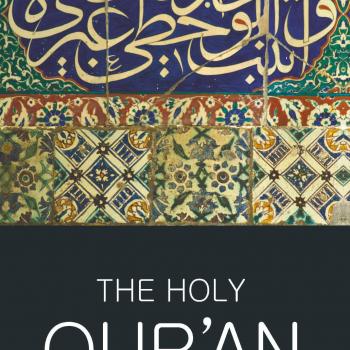I have been a member of the Society of Biblical Literature (SBL) since 1999. Since then, I have attended all of its Annual Meetings except one. The American Academy of Religion and SBL join together to hold this Annual Meeting. These meetings are held the weekend prior to Thanksgiving in the large downtown convention center of a large city in North America. Thousands of scholars who are members or SBL and AAR attend. Perhaps a thousand sessions or more of approximately 2.5 hours are conducted in which, typically, a panel of scholars deliver papers, respond to them, and then there is Q&A from the audience. Some sessions are attended by hundreds of members. It can be a very exhilarating and enlightening experience for Bible students.
Attending SBL’s Annual Meeting is often a highlight of my year. Besides the sessions, a big feature of it is the large Book Exhibit Hall. Therein, religious book publishers have booths to display their many books that members can purchase at usually a 40-50% discount. Thus, members spend hours in the Book Exhibit browsing the most recent theological books. This is the greatest way to stay abreast of what is happening in biblical scholarship.
This year, the Annual Meeting of SBL/AAR was held at the downtown convention center in San Antonio, Texas. Usually, I attend the Annual Meeting 3-4 days, but this year I was only there two full days. I attended three sessions. One was on Jesus’ parables. My friend, Dr. Klyne Snodgrass, was one of speakers because he wrote a large book on Jesus’ parables entitled Stories with Intent: A Comprehensive Guide to the Parables of Jesus, published by Eerdmans. One of the things Klyne said was that he is skeptical of the existence of Q.
Scholars use Q to refer to a hypothetical, ancient document they call “quelle,” which means “source” in German. Many biblical scholars believe Q contained many sayings of Jesus, as do the New Testament gospels and supposedly the Gospel of Thomas; the Gospel of Mark was the first of the four NT gospels written and published; the Gospels of Matthew and Luke were written with Q and Mark as their main written sources, which scholars call the Two-Source Hypothesis. However, there is no evidence in patristic writings that Q ever existed. Although I am pretty much a novice about Q, I did write a harmony of the gospels (The Gospels Interwoven, 1987). I’ve always felt since that experience that the Two-Source Hypothesis does not stand up to scrutiny.
But the session I was looking forward to the most was conducted by the International Qur’anic Studies Association on the question, “The Qur’an as a Violent Text?” I have posted about this issue multiple times. (Click here on the following: “Are We Doing Enough About Islamic Suicide Bombers?,” “Are Muslims Being Radicalized with the Qur’an?,” “Did El-Sisi Say Revise the Qur’an?,” “El-Sisi Is Not the Only Muslim Questioning the Qur’an, “Radical Islamists: ‘Discredit Their Ideology.'”)
There were six speakers. All were Muslims except one, who was an authority on the history of Islam. Although it was never discussed, underlying this session was the reality of widespread Islamic terrorism presently in the world. Here are some points these speakers made about this subject (“sura” in the Qur’an is similar to “chapter):
- Violence in the Qur’an should not be surprising since violence is a characteristic of human nature and even creation.
- Readers of the Qur’an should not focus on certain texts that may have violence but should focus on the the entire Qur’an, most of which is not about violence.
- Texts about violence are descriptive, not prescriptive.
- Readers should look for various levels of meaning in violent texts.
- Readers should avoid interpreting violent texts literally.
- Some Qur’anic texts cancel others, so some violent texts are thereby canceled.
- The Qur’an must be understood contextually, that is, according to the activities Muhammed (founder of Islam) when he wrote or uttered them. Thus, certain violent texts were written when Muhammed had just conducted some battle, so that readers should not necessarily apply such texts to their own situation. For example, Sura 8 is “a salvation warfare sura,” with its context being a certain battle. For example, Sura 8.12 says, “God revealed his will to the angels, saying, ‘I shall be with you. Give courage to the believers. I shall cast terror into the hearts of the infidels. Strike off their heads, strike off the very tips of their fingers.'”
- Sura 4.34 was discussed. It says, “Men have authority over women because God has made the one superior to the other, and because they spend their wealth to maintain them. Good women are obedient…. [the disobedient] beat them.
- The verse, “slay them wherever you find them,” refers only to pagans, Hindus, and Buddhists during the time in which it was written.
- Not discussed specifically were the many Qur’anic verses that command, “Fight for the cause of God.” Also, “they will slay and be slain.”
- Sura 5.52 was mentioned but not discussed, “Believers, take neither the Jews nor the Christians for your friends.”
- Sura 5.39 was mentioned, “As for a man or woman who is guilty of theft, cut off their hands to punish them for their crimes.” But there is ambiguity with the addition, “But whoever repents after committing evil, and mends his ways, shall be pardoned by God.”
Overall, I was not satisfied with these explanations about violence in the Qur’an. Of course, whenever a Jew or Christian talks about violent texts in the Qur’an, listeners often claim the same occurs in the Bible. I think there is a significant difference. The Old Testament merely records much history that includes violence, whereas the Qur’an, as I read it, does much commanding of violence.













